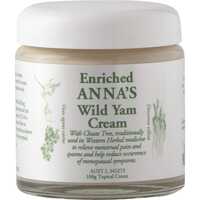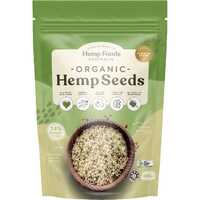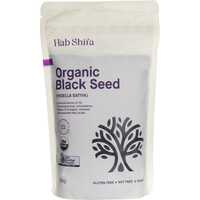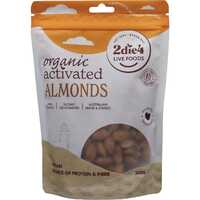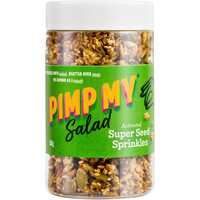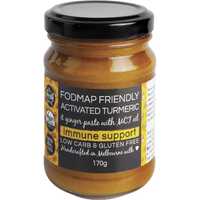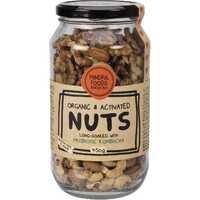With nothing more than water, time, and a little salt, you can make many foods easier to digest and more nutritious. Food activation is a simple process that helps to remove enzyme inhibitors and maximise the impact of beneficial nutrients. You can soak nuts, seeds, grains, and legumes in water — breaking down phytic acid and making your favourite foods easier to eat.
Let's look at the wonderful world of activated food. Whether you want to soak ingredients at home or buy pre-activated products from a health food store, soaking food in water is a simple and effective way to boost your nutritional intake.
What Are Activated Foods?
The food activation process involves soaking various foods in water, normally with some kind of solution or salt to help break down phytates and polyphenols. A range of foods can be activated, including nuts, seeds, grains, and legumes. While soaking is the only thing necessary for activation, adding an acidic or alkaline solution or salt can enhance and speed up the process. After soaking foods, they are normally drained and dehydrated at very low temperatures to make them ready for eating. Activated foods are easy to make at home with basic ingredients, and quality products are readily available from health food stores.
The Benefits of Activated Foods
When nuts, seeds, and other foods are left to soak in the perfect environment, the process of sprouting is triggered. When this occurs, a number of things happen. First and foremost, the food springs to life, as the soaking process simulates the early stages of germination. In many cases, sprouted foods have a richer vitamin, mineral, and antioxidant profile than non-sprouted foods. Activation is similar in many ways to sprouting, but the process stops before visible sprouts have emerged.
Second, lots of unwanted toxins are removed from the food, including phytic acid inhibitors, polyphenols, and various enzymes. Phytic acid, or phytate, is the primary form of phosphorus storage in many plants. Whether you're talking about nuts, grains, or legumes, this acidic compound binds to essential minerals like iron, zinc, and calcium. When this happens, it can influence how these important nutrients are absorbed by your body. While activation doesn't always change the nutritional profile of foods, it can make them easier to digest and more functionally nutritious.
Last but not least, the activation process changes the texture and flavour of the food. While the final outcome depends on the food selected and the length of activation, the end results can be rather delicious. Much like the difference between raw nuts and roasted nuts, activated foods have their own unique taste sensations. When you have slightly different flavours at your disposal, you're likely to enjoy healthy foods more often. Activating foods can also make them easier to work with. For example, it helps dried beans and whole grains to look fuller and cook more evenly.
What Foods Can be Activated?
A wide range of foods can be activated, including nuts, seeds, grains, and legumes. This list includes some of the healthiest foods in the world, and the activation process makes them even more nutritious. Let's take a look at common activated foods and the many benefits they provide:
Nuts
However you eat them — raw, roasted, or activated — nuts are dense with nutrients and full of flavour. Nuts are high in protein; full of essential fats; and heavy with fibre, minerals, and antioxidants. Eating large quantities of nuts can put pressure on your digestive system, however, which can lead to digestive symptoms like bloating and nausea. In this scenario, activated nuts may be the answer.
The activation process is rather easy, just place your nuts in a large bowl and add a saltwater solution. Once they have been soaked for 6-12 hours, strain the mixture, rinse the nuts, and dry them in a baking tray or dehydrator rack at a super-low temperature. When your nuts are dry and crispy, they can be removed and eaten. If you don't have the time or patience to do this yourself, activated nuts and other foods are readily available from health food stores.
If you want to try activated nuts, the following five examples are great options to start with:
Almonds
Almonds have one of the highest fibre counts of all nuts, and they're loaded with antioxidants. This helps to lower your cholesterol levels, and it also helps you feel full and avoid unhealthy snacks. Almonds also contain lots of healthy fats, protein, magnesium, and vitamin E. They are particularly high in phytic acid, which makes them the perfect candidate for activation.
Brazil Nuts
Brazil nuts pack a lot of punch, with the makeup of these delicious snacks helping to support thyroid function, prevent cell damage, and possibly reduce inflammation. Brazil nuts are very rich in nutrients, with lots of protein, fat, vitamin E, copper, magnesium, phosphorus, and zinc. A single Brazil nut also provides more than 100% of the recommended daily allowance of selenium.
Cashews
Cashews are rich in protein, fibre, and healthy fats; and they also have lots of vitamins, minerals, and beneficial plant compounds. However, much like almonds, the phytates in cashews make it hard for your body to absorb these beneficial compounds. Soaking your cashews is a great way to reduce their phytate content. Activated cashews easily get slimy and lose their flavour, however, so it's important to limit soaking time and dry them rapidly for the best texture and taste.
Macadamias
The great Australian nut, macadamias are one of the healthiest and most calorie-dense nuts in the world. They contain numerous healthy fats, various essential nutrients and antioxidants, and lots of dietary fibre. Macadamia nuts are great for soaking, and because they're softer than most, they're ready for eating much sooner. Anywhere from 20 minutes to 3 hours can be beneficial, which is much less than the 8-12 hours recommended for many other nuts.
Hazelnuts
Hazelnuts are jam-packed with macro and micronutrients, from healthy omega-3 fats to vitamins, minerals, and antioxidant compounds. These nuts are widely recognised for their rich nutritional profile and fantastic health benefits. However, they also contain high phytic acid, which can impair the absorption of some minerals without soaking. Hazelnuts are among the hardest of all nuts, and just like almonds, around 12 hours of soaking time is advised.
Seeds
Just like nuts, seeds make the perfect healthy snack. Their small size hides a range of health benefits, many of which are enhanced through the activation process. While all seeds are different, they share a number of health benefits. They're a great source of fibre, they contain lots of healthy fats, and they have plenty of essential vitamins and minerals. Lots of seeds are great for soaking, and due to their small size, the process is generally fast and convenient. If you want to activate seeds, the healthiest options are flaxseeds, chia seeds, hemp seeds, sesame seeds, pumpkin seeds, and sunflower seeds.
Grains and legumes
Common grains can be activated just like nuts and seeds, and they provide some of the same benefits. You can soak many grains in water and bring them back to life, including rye, oats, barley, quinoa, and wheat. You can also soak rice, buckwheat, spelt, and millet; but these grains contain fewer phytates so it's not really essential. Whole rice and whole millet contain even fewer phytates, so soaking them is a matter of preference.
After being activated and dried, these whole food ingredients can be substituted for regular flour and used to make breads, cakes, and biscuits. If you want to activate legumes, it's easy to get started with common examples like lentils, chickpeas, and soybeans. Adding a touch of apple cider vinegar to your mixture helps grains and legumes to activate better and faster.
An Important Note on Phytates
Food activation helps to boost nutrition by removing phytates and aiding the digestive process. It's important to note, however, that phytic acid also has beneficial properties. While this substance binds certain minerals and prevents them from being absorbed, it also has a number of antioxidant and anti-inflammatory qualities. In some studies, it has even shown promise against kidney stones and some forms of cancer. While reducing phytic acid through sprouting and activation can be advantageous in many ways, it's perfectly fine to mix activated ingredients with raw nuts, seeds, grains, and legumes. While some health practitioners recommend activating all of your nuts and seeds, like most things in life, moderation is usually the best policy.
If you want to experience the benefits of activation, Healthy Being has everything you need. We have lots of raw products ready for soaking, including nuts, seeds, grains, and legumes. If you don't have the time or patience to do your own soaking, we also have lots of pre-activated mixtures ready to enjoy. So visit our website today for unbeatable prices and enjoy free shipping options across Australia and worldwide delivery!


 Certified Organic
Certified Organic Vegan Friendly
Vegan Friendly  Vegetarian
Vegetarian Organic Ingredients
Organic Ingredients Dairy Free
Dairy Free Gluten Free
Gluten Free Keto Friendly
Keto Friendly

















